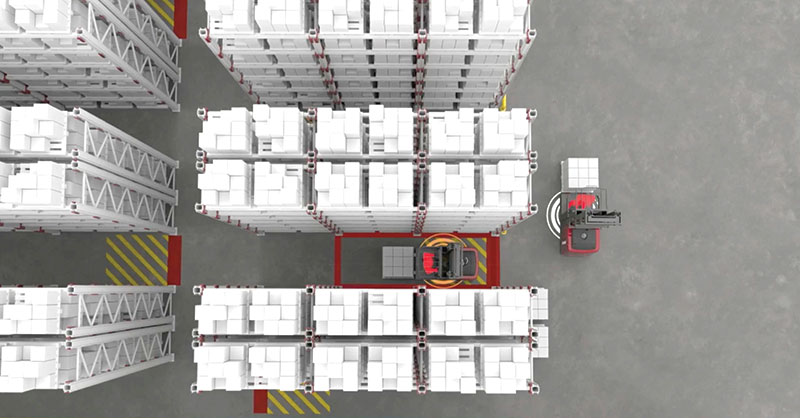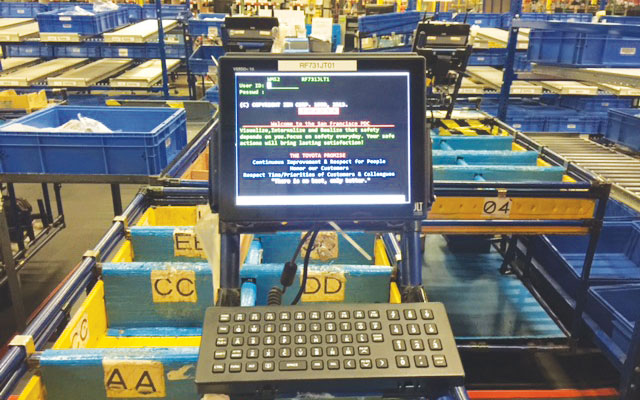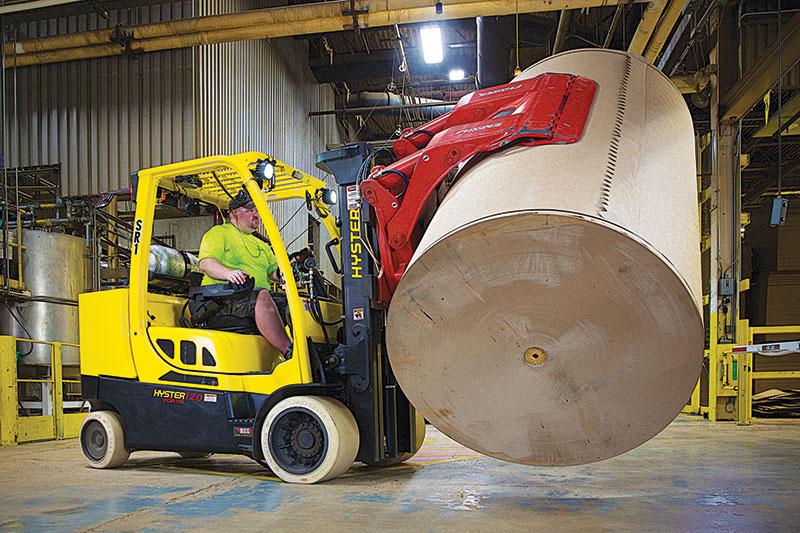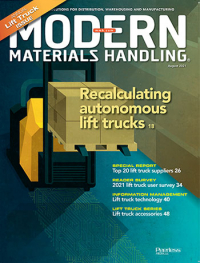Lift truck accessories matter
Lift truck fleet managers and operators expect more data about everything from seats and tires to on-board technologies that put critical information front and center. These advances are the only way for operations and drivers to keep pace with demands.
![]() This is no time to make light of lift truck accessories. It just isn’t in your best interest to understate their importance to either a lift truck’s productivity or that of your people. Not to mention safety.
This is no time to make light of lift truck accessories. It just isn’t in your best interest to understate their importance to either a lift truck’s productivity or that of your people. Not to mention safety.
For this article, we talked to suppliers of traditional accessories—tires, seats, terminals and their mounts and attachments, to name four. We also talked to suppliers of fleet management technologies of various stripes. If you still don’t think those are part of the accessory picture, then you’re already underachieving.
It didn’t matter which accessory was the topic of the interview, the value of keeping lift trucks up, running and at their most efficient was always front and center. The same was true for operator safety and productivity. Clearly, accessory suppliers consider the truck and operator to be a single unit that they have at least partial responsibility for.
Tim Hall, account manager for materials handling seats at Grammer says this: “The philosophy of seats is changing. We’re moving from lowest cost regardless of operator comfort and shock mitigation to a much greater awareness of the seat’s features and their impact on operator comfort.”

He said that about seats? Seriously? After all, the United States has long been known to make lift truck seats a very secondary consideration. In fact, many companies would much prefer that operators stood, believing they remain more engaged and alert. That’s in stark contrast to Europe’s long-standing interest in seats for operator comfort and ultimately productivity. That’s worth at least one thoughtful moment on your part.
Reggie Collette, director of sales and marketing at Thombert, notices a similar trend with tires. “The approach of one-size-fits-all is gone from the tire decision now,” he says. “Warehouses are getting larger and lift truck speeds are often 10 mph not 4 mph. That adds to the wear on tires, so selecting the right compound is increasingly important. You also have to train operators on how to most effectively use that truck in these new, more expansive environments.” Tires matter, too? You bet.
Read on to understand the latest in several key lift truck accessories. It’s worth money to you.

Seats and tires
Since we’ve already introduced tires and seats, we’re going to stay with them for now.
Collette, whose company focuses solely on polyurethane wheels and tires, not rubber ones, says not only have warehouses changed, but so has usage of specific lift truck types.
That means you have to understand your floor conditions. For instance, one level of dampness dictates a specific tire hardness and design for maximum grip on the floor. A higher level of dampness requires grooves cut into the tires to displace water more actively and increase traction. But that’s only the beginning, Collette adds. It is now critical to monitor tire condition. You can no longer just assume they’re good enough. He recommends regular inspections and a maintenance schedule. It’s also important to record and track tire data.
Collette calls it manual telematics. And he assures those listening that the day is coming when tire condition will be part of the telematics monitoring already done electronically in the operator cab to track truck usage and condition. He says that understanding cost per hour of operation for tires is critical to understanding the real cost of ownership.
As was already said, seats are taking on new importance. It’s little wonder when operators get on and off trucks 50 or 60 times a day.
That means, says Hall of Grammer, that low-profile seats are in the spotlight as are built-in hip guards that maintain the position of the operator in the seat.
And a new control in seats can help operators avoid collisions. Called “haptic warnings,” these vibratory signals built into the seat warn the operator of a danger. Hall says the fact the signal vibrates makes it as prominent as possible, unlike audible signals that can get lost in all the other sounds of a warehouse.
Workhorse attachments
Whether it’s a carton clamp or a standard fork tine, attachments have long provided productivity leverage to lift truck operators. And with some new technology twists, that leverage is increasing. Or as Pete Drake, senior vice president of operations for the Americas at Cascade, says, “attachments are much more than steel these days.”
Jason Gaydos, major and national accounts manager at Bolzoni, says the latest improved attachments make load handling safer and more efficient while reducing damage to the product being handled. “In addition, there has been most recently an increasing emphasis on making the work safer for the lift truck operator. In fact, operator well-being is now at the forefront of most attachment selection decisions,” says Gaydos.
For instance, both Cascade and Bolzoni offer tines with high-resolution cameras and sensors that monitor load handling. The idea is to give the operator a strong visual with an onboard terminal of the relative position of the tines and the load. “This lets the attachment simplify handling,” explains John Regan, vice president of sales and marketing at Bolzoni.
Mobile weighing with scales built into the tines is another innovation from both Bolzoni and Cascade. Applications range from overload protection to inventory control and even order picking.
As Drake explains, these and related technology additions to attachments tend to take operator guesswork out of handling loads, especially ones that may be more prone to damage if mishandled. “Technology here has grown so much in the past 18 months with the acceleration in automation and e-commerce activity, making digital data available to systems ranging from on-board telematics to warehouse management systems,” Drake adds.

Operators connect direct to data and software that streamline processes through on-board terminals.
On-board terminals and mounts
“For the first time, mission critical information flow to lift truck drivers is now an imperative, not just a buzz phrase,” explains Glenn Lundgren, business development executive at JLT Mobile Computers.
Ultimately, onboard terminals of all shapes and sizes provide that information directly to the operator, ensuring information is available to streamline workflows and processes. While not new in and of itself, a proliferation of rugged onboard terminals includes full-size tablets, smaller handhelds as well as bar code scanners and on-board printers. “You have to put the right tech in place to connect to the right data and software to provide task specific information directly to the operator,” adds Lundgren.
Convenience for the operator is essential here, explains Chad Sullivan, design engineer at terminal mount manufacturer Gamber-Johnson. That requires mounts designed for ease of use when the device is sitting in place as well as ease of removal and replacement for mobile applications, Sullivan continues. This also requires attention to power cords required to run all tech without downtime.
Rugged design of mounts protects the devices from jostling as lift trucks, which don’t have shock absorbers, simply make their rounds in the facility, adds Sullivan. The objective is to get five to seven years of continuous use from tech devices on trucks, explains Lundgren.
Meanwhile, the technology inside the devices is changing. The current leading shift is to Android due to its openness and ease of use, adds Lundgren. However, the shift away from Microsoft as it withdraws support for these applications is still underway.
“In the end, devices and their mounts on lift trucks are all about making operators as safe and productive as possible without increasing their workloads,” says Lundgren.
Fleet management technologies
Adoption of technology to improve management of individual lift trucks and entire fleets continues to expand. In fact, 41% of companies say they have already adopted fleet management technologies. That’s according to the Modern Materials Handling “Lift Truck Acquisition and Usage Study” conducted earlier this year.
The top four uses of these technologies and software are to track maintenance history, safety, maintenance costs and level of utilization. As the survey indicates, success here is substantial with 43% saying their efforts are extremely or very successful and another 54% calling them somewhat successful.
Or as Erica Moyer, iWarehouse product manager for RTLS and Pick2Pallet at The Raymond Corp., puts it, “the future of this technology is now.” She continues to say, “fleet management and operator assist technologies are a fundamental aspect to improve operating efficiency while ensuring lift truck operators are confident and comfortable. They are operational table stakes going forward.”
Chris Reeves, product manager at Collective Intelligence Group, explains, “these technologies give managers more control and drivers more accountability. They create efficient, three-way communication between supervisors, forklift vehicles and drivers, and increase safety and productivity while helping to optimize fleet operations.”
Both Collective Intelligence and Raymond offer telematics that control who can actually drive the truck, how it is used and the condition it is in at any given moment. That allows fleet managers to better allocate their lift truck resources for maximum impact.
Most recently, Raymond has added a real-time location system that “reinforces facility rules and supports proper Raymond lift truck operation,” explains Moyer. The patented ultra-wide-band technology tracks trucks and pedestrians, ensuring they operate in designated areas to maximize routes and minimize congestion and potential incidents. It is fully integrated with the company’s telematics solution.
So, from seats to real-time location systems, lift truck accessories are bringing technology ever closer to the exact location where work is being done. That makes both operators and operations winners.

Article Topics
Lift Trucks News & Resources
BSLBATT is looking for new distributors and resellers worldwide Hyster recognizes Dealers of Distinction for 2023 Carolina Handling names Joe Perkins as COO Toyota Material Handling North America appoints Mark Taggart as CFO Learn from lift truck service history Toyota Material Handling honors its top forklift dealers in North America Fleet Team expands with strategic acquisition of Forklift Training Systems More Lift TrucksLatest in Materials Handling
Beckhoff USA opens new office in Austin, Texas Manhattan Associates selects TeamViewer as partner for warehouse vision picking ASME Foundation wins grant for technical workforce development The (Not So) Secret Weapons: How Key Cabinets and Asset Management Lockers Are Changing Supply Chain Operations MODEX C-Suite Interview with Harold Vanasse: The perfect blend of automation and sustainability Consultant and industry leader John M. Hill passes on at age 86 Registration open for Pack Expo International 2024 More Materials HandlingAbout the Author
Subscribe to Materials Handling Magazine

Find out what the world's most innovative companies are doing to improve productivity in their plants and distribution centers.
Start your FREE subscription today.
April 2024 Modern Materials Handling

Latest Resources












